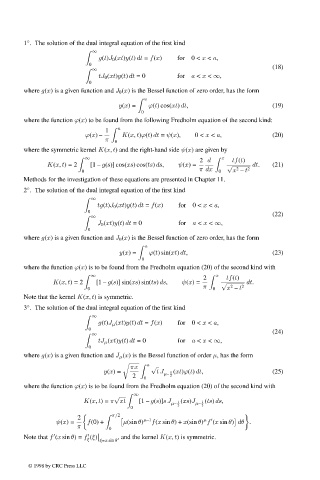Page 536 - Handbook Of Integral Equations
P. 536
◦
1 . The solution of the dual integral equation of the first kind
∞
g(t)J 0 (xt)y(t) dt = f(x) for 0 < x < a,
0
(18)
∞
tJ 0 (xt)y(t) dt =0 for a < x < ∞,
0
where g(x) is a given function and J 0 (x) is the Bessel function of zero order, has the form
a
y(x)= ϕ(t) cos(xt) dt, (19)
0
where the function ϕ(x) to be found from the following Fredholm equation of the second kind:
a
1
ϕ(x) – K(x, t)ϕ(t) dt = ψ(x), 0 < x < a, (20)
π
0
where the symmetric kernel K(x, t) and the right-hand side ψ(x) are given by
x
∞ 2 d tf(t)
K(x, t)=2 [1 – g(s)] cos(xs) cos(ts) ds, ψ(x)= √ dt. (21)
2
0 π dx 0 x – t 2
Methods for the investigation of these equations are presented in Chapter 11.
2 . The solution of the dual integral equation of the first kind
◦
∞
tg(t)J 0 (xt)y(t) dt = f(x) for 0 < x < a,
0
(22)
∞
J 0 (xt)y(t) dt =0 for a < x < ∞,
0
where g(x) is a given function and J 0 (x) is the Bessel function of zero order, has the form
a
y(x)= ϕ(t) sin(xt) dt, (23)
0
where the function ϕ(x) is to be found from the Fredholm equation (20) of the second kind with
∞ 2 tf(t)
x
K(x, t)=2 [1 – g(s)] sin(xs) sin(ts) ds, ψ(x)= √ dt.
2
0 π 0 x – t 2
Note that the kernel K(x, t) is symmetric.
3 . The solution of the dual integral equation of the first kind
◦
∞
g(t)J µ (xt)y(t) dt = f(x) for 0 < x < a,
0
(24)
∞
tJ µ (xt)y(t) dt =0 for a < x < ∞,
0
where g(x) is a given function and J µ (x) is the Bessel function of order µ, has the form
a
πx √
y(x)= tJ µ– 1 (xt)ϕ(t) dt, (25)
2 0 2
where the function ϕ(x) is to be found from the Fredholm equation (20) of the second kind with
√ ∞
K(x, t)= π xt [1 – g(s)]s J µ– 1 (xs)J µ– 1 (ts) ds,
0 2 2
π/2
2 µ–1
µ
ψ(x)= f(0) + µ(sin θ) f(x sin θ)+ x(sin θ) f (x sin θ) dθ .
π 0
Note that f (x sin θ)= f (ξ) , and the kernel K(x, t) is symmetric.
ξ ξ=x sin θ
© 1998 by CRC Press LLC
© 1998 by CRC Press LLC
Page 518

